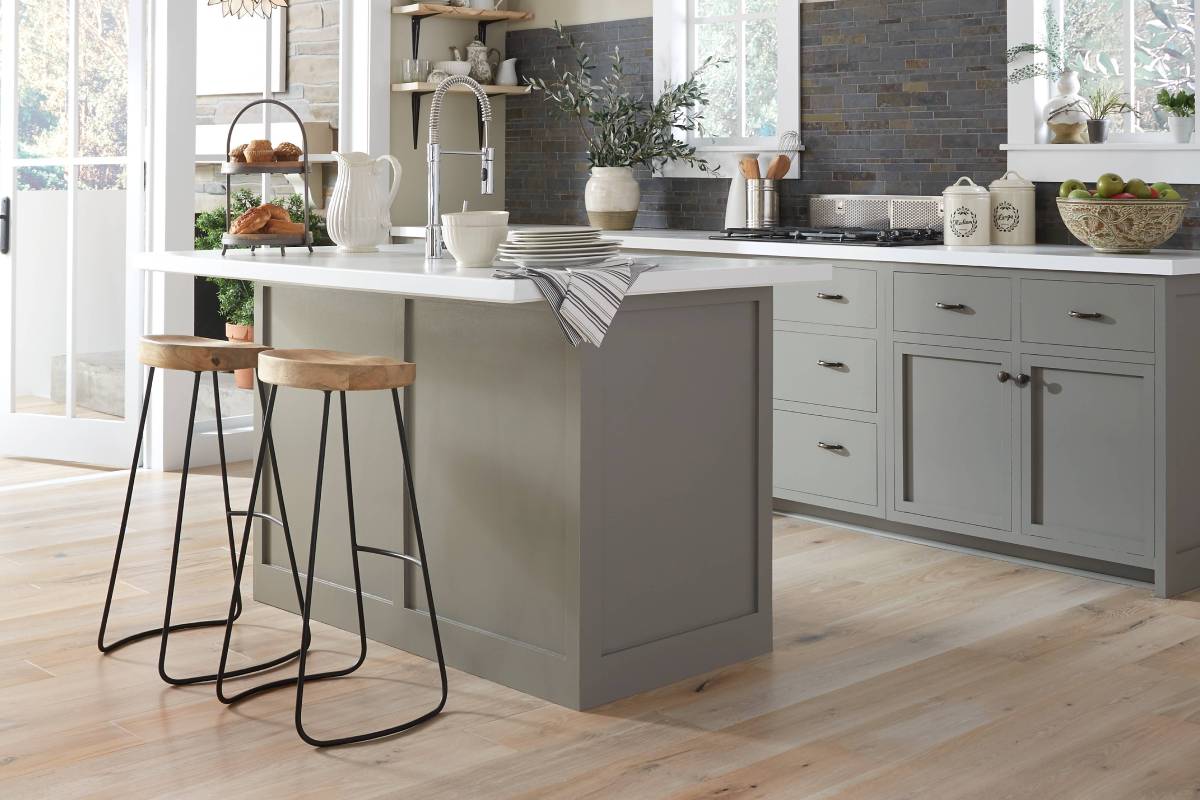





Classic hardwood floors add rich character and warmth unmatched by other flooring types. The vast number of options can make choosing your flooring feel overwhelming. Rest assured, the experts at Preferred Flooring will guide you through selecting your wood species, color, and every other detail right down to the level of luster to ensure you will love your new hardwood floors for decades to come.
You may be thinking, “Engineered hardwood? Doesn’t that mean it’s fake?” Not at all. The primary difference between the two types of hardwood is that solid hardwood is crafted using a single plank, while the engineered variety is made with a hardwood surface and crisscrossing levels of pressed plywood underneath. These layers make engineered hardwood less likely to shift, expand, or contract during shifts in humidity and temperature.
Solid hardwood is best reserved for rooms in your home above grade level, such as dining rooms, living rooms, and bedrooms. Engineered wood floors are a great choice in the same spaces as hardwood but can also be used below grade in basements and over radiant heating systems. Engineered hardwood is also a bit thinner than most solid options making it an excellent solution for home projects in which your hardwood floor needs to match the height of an adjoining floor.
Now let’s talk about durability. New flooring of any material is a significant investment— you want to make sure you choose a wood that will stand up to your lifestyle. Each wood species has its own hardness level: Cherry wood is the softest of the hardwoods, while hickory is the hardest. In areas with heavy traffic or lots of activity, you’ll want to go with a harder species to help prevent scratches and dents.
Classic hardwood floors can be sanded and refinished if you want to change the look, but choosing a color you love that works well with your current decor will save you time and money. A general rule to follow when choosing wood color is that light colors make spaces feel more open, while darker shades reduce visual space and make larger areas feel cozier. You also want to avoid matching your floor to your wood trim and furnishings, or you risk having a room design that looks cluttered.
Grey hardwood floors have been growing in popularity as they give homes a contemporary, minimalist aesthetic. Grey is a neutral shade, like tan or brown, so it can be paired with nearly any style. Dark grey hardwood floors dramatically contrast light-colored walls or brightly colored furniture and accents. A bonus of grey flooring is that it shows dust less obviously than darker brown wood, so you don’t have to worry about cleaning it as frequently. Who doesn’t like the sound of that?
Do you want your floors to make a statement? If you do, consider black hardwood floors. We’re not talking dark wood or stain, but literal black hardwood. Black hardwood floors give rooms an upscale appearance and create a stunning contrast with white or grey cabinetry or furniture. A caveat to opting for black hardwood is that it’s more challenging to maintain. It shows dirt and scratches prominently, but if you’re willing to put in a little extra TLC, we promise that black hardwood will be well worth it.
The best way to decide what color hardwood is suitable for your home is to use samples. Narrow your choices down to two or three colors, then place the samples in the room where the new flooring will be installed. Leave the samples for a few days to let yourself acclimate to what it will be like to have that color more permanently.
Hardwood floors are an investment in your home that will increase its value should you ever decide to sell. Even if you plan to stay in your home for many more years, you’ll still want to keep your floors looking pristine, and it’s relatively easy to do.
A little bit of daily upkeep goes a long way in maintaining your hardwood flooring. A broom or dust mop is the best tool, but you can also use your vacuum’s wand attachment. If you’re using a vacuum, make sure it’s set to “bare floor” so the roller doesn’t scuff the floor’s finish.
From time to time, you’ll want to do a deeper clean using a microfiber mop and a product specifically designed for hardwood floors. Avoid mopping your floor with water as the moisture can cause warping or water spots, and always avoid any products with harsh chemicals like ammonia, wax, bleach, or vinegar.
Preventing damage from occurring in the first place is always easier than trying to make repairs. Clean any spills as quickly as possible to avoid moisture penetration or staining. Use floor mats and area rugs in high-traffic areas to help contain any dirt and debris, and never wear shoes on your floors. We also recommend keeping your pets’ nails trimmed and using felt pads on furniture legs to prevent scratches and grooves.
Our flooring experts are ready to help you select classic hardwood floors for every room in your home. We have been your premier flooring resource for 15 years and offer the best customer service in the industry. Contact us today at (618) 526-9393 for a free, no-obligation estimate. Our showroom is in Breese, IL, and we are happy to serve the areas of Breese, Bond County, Clinton County, Madison County, Monroe County, Randolph County, St. Clair County, and Washington County, IL.

